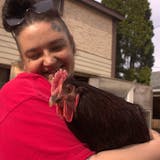Opinion editor's note: Star Tribune Opinion publishes a mix of national and local commentaries online and in print each day. To contribute, click here.
•••
Not far south from our study area along Hwy. 53 there's a new billboard with a spotted and spindle-legged deer fawn standing alert and angelic in summer grass. In the image, the forest edge beyond the fawn appears as if on fire, with glowing sparks and embers flying from blurry flames that fade right to left into a smoky then charred background that highlights yellow letters stating: "Wolves devour over 54,000 fawns a year in Minnesota."
What's the point? Let's ignore that the "over 54,000" figure is likely an overestimate. Visually, the billboard makes a plea to save helpless Bambi from ending up in the belly of a wolf. The background message is that wolves are just as big a threat to fawns as forest fires. The statement is meant to be sensational: Wolves aren't just trying to survive and feed their pups, they devour deer. Baby deer. 54,000 baby deer a year, right here in Minnesota.
The billboard's appearance is well-timed and placed along the northbound lane to anticipate the fall hunting seasons and appeal to hunters traveling up to deer camp in coming months. Those who paid for the billboard, the Minnesota Deer Hunters Association-Sturgeon River Chapter, write on social media that the point of the message is: "We support wolf management. The wolf numbers are over the states [sic] recommended projections for a healthy wolf population, yet no wolf hunt."
Set aside the fact that policy to not hold a hunt is a form of wildlife management and that Minnesota wolves are federally protected currently, precluding state wolf hunts. Billboard supporters would have you believe that hunting wolves would surely help more fawns survive. But this stands in stark contrast to the best available science and instead makes the faulty assumption that if a wolf doesn't devour a fawn, that fawn survives.
A fawn not eaten by wolves might get shot by hunters. Over the past five years, deer hunters have reported to the Minnesota Department of Natural Resources that they have killed an average of about 25,000 fawns annually. A fawn not eaten by wolves might be among the 40,000 or more deer hit by vehicles in Minnesota each year. Or maybe it will be eaten by a coyote or bear, or slowly starve, or get killed by a combine in the first hay cutting, or be moved by humans and abandoned by mom, or die from a viral disease that is spreading north and is uncontrollable, such as epizootic hemorrhagic disease.
Fawns die from many causes and the causes of mortality can compensate for one another. Increased mortality due to one cause often means less mortality from a different cause. And yet — very importantly here — the overall rate of fawn survival can remain unchanged.


